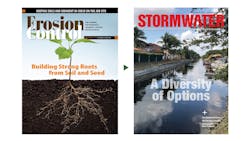WELCOME the final edition of Erosion Control magazine! Don’t worry though, we’re not disappearing—just moving.
For the last 26 years, Erosion Control magazine has been providing quality content for those involved in protecting and caring for one of our most important resources—the soil that sustains us all. Beginning in January 2020, Erosion Control magazine will merge with Stormwater magazine. The new combined monthly magazine will continue to be the premier resource for professionals involved in the design, control, and management of stormwater runoff and erosion control.
The new, merged magazine and website will maintain the Stormwater name and design while continuing to provide the erosion and sediment control-specific editorial content you know and trust from Erosion Control. You can find more information on the new combined website, www.stormh2o.com. In the meantime, our last issue promises to be a good one.
When it comes to implementing sediment and erosion control best practices during a construction project, a viable estimate is indispensable. In her Guest Editorial, Rifka Malik, CPESC, CPE, and president of Sitework Estimating Services, discusses the importance of proper estimates in positioning a construction project for success.
In “Keeping Down the Dust,” a small, family-operated erosion control business found a niche doing post-fire remediation Northern California. Matt Kearns of Grassroots Erosion Control discusses the challenges of hydromulching and providing perimeter control after the Camp Fire.
In California, the end of the fire season marks the start of the rainy season, which can result in significant debris flows and endanger life and property. In “Eyes in the Sky,” geologist and an unmanned aerial systems (UAS) pilot Robert Leeper discusses using drones to create high-resolution 3D models of burn areas for anticipating where debris may flow during a rainstorm and tracking changes on a storm-by-storm basis.
Researchers from the University of Manchester in England have developed a tool to help coastal engineers understand how strong winds amplify waves that crash against and overtop shoreline defenses such as seawalls. Lead researcher, Dr. Jian Zhou of the University of Manchester in England, spoke with Erosion Control about the project and its applications in “Protecting Coastlines from Wind-Blown Waves.”
We hope you enjoy this final edition of Erosion Control. From all of us at Endeavor Business Media, a heartfelt thank you to all our readers for making this magazine the premier resource for erosion and sediment control professionals. We look forward to continuing to share the quality erosion-specific content you’ve come to expect in the pages of the new combined magazine. See you there!






